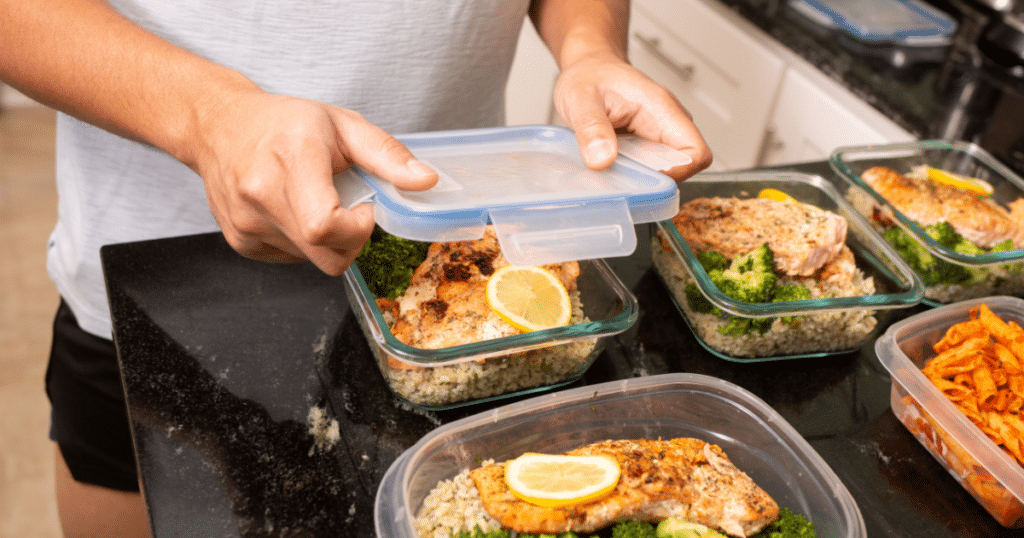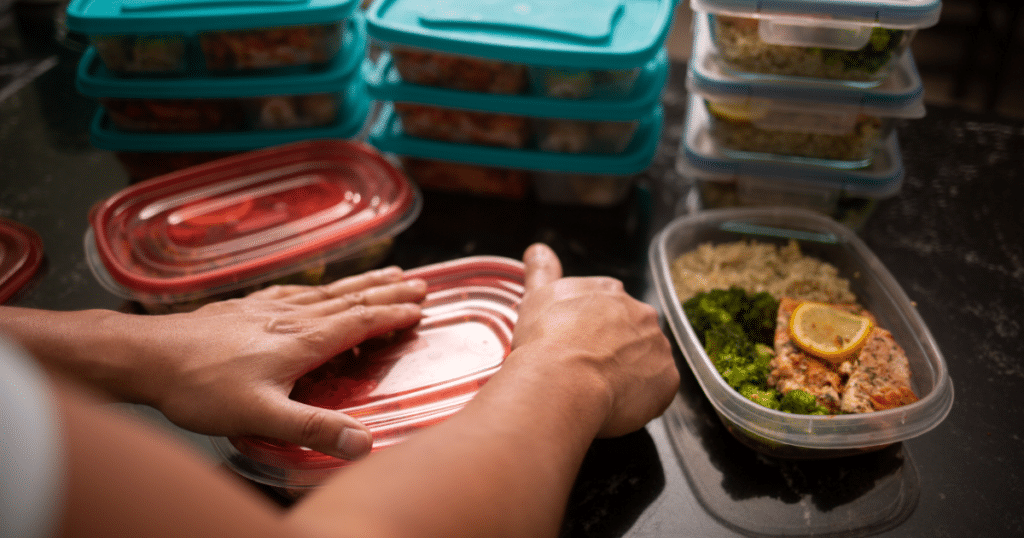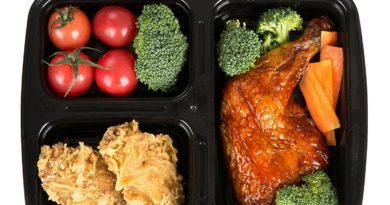Meal Prepping Simplified: Here’s Everything You Need to Know
In our fast-paced world, it’s easy to fall into the trap of convenience foods and takeout. We trade our health for a few saved minutes, but what if there was a better way? Meal prepping is the simple, transformative solution you’ve been looking for.
Meal prepping, the art of preparing meals in advance, is a game-changer for simplifying your life and nourishing your body. The meal prep market was valued at $5.68 billion in 2024 and is projected to grow, showing just how many people are embracing this lifestyle.
As a certified sports nutritionist and strength coach, I’ve seen firsthand how planning meals helps clients achieve their fat loss and muscle-building goals. This guide will uncover the secrets to making meal prepping a joyful and sustainable part of your routine. Say goodbye to mealtime stress and hello to a healthier, more efficient you!
Disclaimer: This article is for informational purposes only and is not meant to treat or diagnose any condition. It is recommended that you speak with your doctor before starting any exercise program, changing your daily nutrition, or adding any supplements to your regimen.
Table of contents
Key Takeaways
- Start Small & Define Your “Why”: Don’t try to prep 21 meals in your first week. Begin with a few lunches and clearly define if your goal is weight loss, saving money, or eating healthier. This focus makes planning easier.
- Invest in Quality Containers: The right tools make a difference. Choose divided, airtight containers like those from Bentgo or durable, oven-safe glass options from Prep Naturals to keep food fresh and portions controlled.
- Embrace “Component Prepping”: Instead of making full meals, cook versatile ingredients in batches. Think grilled chicken, roasted vegetables, and quinoa. This allows you to assemble different combinations throughout the week to prevent flavor fatigue.
- Don’t Fear the Freezer: According to FDA guidelines, most cooked meals last 3-4 days in the fridge. To prep for a full week, freeze meals for day 5-7 and transfer them to the fridge the night before to thaw.

How to Start Meal Prepping
Starting your meal prep journey is easier than it looks. With a few key steps, you can master this invaluable skill and reclaim your time and health. Here is a practical guide to get you started.
Define Your Goals and Make a Plan
First, know your “why.” Are you meal prepping for fat loss, to save money, or to simply eat healthier? Your goal will shape your menu. Studies show that people who plan their meals are more likely to have a healthier diet and better weight management outcomes.
Once you have a goal, use an app to simplify planning. Tools like PlateJoy or Eat This Much can generate meal plans and grocery lists based on your dietary needs, whether you’re keto, vegan, or just counting calories. This takes the guesswork out of the process.
Get the Right Gear
Good containers are non-negotiable. They prevent spills, keep food fresh, and help with portion control.
- For Versatility: Glass containers from brands like Prep Naturals are a great investment. They are oven, microwave, and dishwasher-safe, and they don’t stain or hold odors.
- For Portion Control: Bento-style containers, like those from Bentgo, have built-in dividers that make it easy to portion out proteins, carbs, and veggies without measuring.
- For Salads & Soups: Mason jars are perfect for layered salads, keeping greens crisp by holding the dressing at the bottom. For soups, consider Souper Cubes, which freeze portions in convenient blocks.
Schedule and Execute Your Prep
Consistency is everything. Choose one or two days a week for your prep session. Many people prefer Sunday, but any day that fits your schedule will work. Start small by prepping just a few days’ worth of lunches or dinners to avoid feeling overwhelmed.
Cook versatile ingredients in batches. This is often called “component prepping.” For example, you can grill a large batch of chicken breasts, roast a sheet pan of vegetables, and cook a pot of quinoa. Then, you can mix and match these components to create different meals, like a chicken salad one day and a quinoa bowl the next. This approach saves time and prevents you from getting bored.
Always let food cool to near room temperature before sealing and refrigerating. Sealing hot food creates condensation, which is a major cause of soggy meals. Label and date your containers so you know what you have and when it was made. According to the Mayo Clinic, leftovers are typically safe for 3-4 days in the refrigerator. For meals you plan to eat later in the week, the freezer is your best friend.
Here’s How You Can Simplify Meal Prepping

Here are some of the most effective strategies you can use when meal prepping.
1. Meal prepping the same foods every day
Eating chicken and brown rice every day sounds boring, doesn’t it? You’re bound to lose interest quickly. Variety is essential not just for your sanity, but also for getting a wide range of vitamins and minerals. The summer months are a perfect time to grill different proteins!
Related Article: Meal Planning to Help You Achieve Your Goals
Instead of eating the same meal on repeat, create a simple rotation. You can prep two different lunch options for the week or use the “component prep” method to build different meals from the same core ingredients. Consider different proteins like beef, chicken, fish, eggs, and turkey. This keeps your meals interesting and your nutrition balanced.
2. Not using condiments
Eating clean doesn’t have to mean eating bland food. There are fantastic low-calorie condiments that can add incredible flavor to what would otherwise be a boring dish.
For example, you can top your food with Sriracha, Frank’s Red Hot Sauce (which has zero calories), or anything from Walden Farms. Other great options include fresh salsa, Mrs. Dash seasonings, mustard, and low-sodium soy sauce. Brands like G Hughes offer sugar-free BBQ and honey mustard sauces that are packed with flavor but have only 10 calories per serving. These simple additions can bring life back to your dishes.
3. Restricting yourself
If you don’t like zucchini pasta, why force yourself to eat it? Extreme restriction is a recipe for failure. A more sustainable approach is IIFYM (If It Fits Your Macros). This gives you the flexibility to enjoy foods you love in moderation.
This doesn’t mean you should eat junk food all day. It means you can have a slice of pizza with your family without derailing your progress. Simply be mindful of your portion size. If you completely cut out all “cheat foods,” you are more likely to binge later. The goal of meal prepping is to create a healthy lifestyle you can stick with long-term, not a short-term punishment.
4. Only consume Tupperware meals
We’ve all seen it, the person at a holiday party or a restaurant with their pre-packed container. While dedication is admirable, this level of rigidity can be isolating and depressing.

You can eat out and still stick to your nutrition plan. If you find yourself at a McDonald’s, you can choose a grilled chicken salad over a Big Mac. At a restaurant, you have the power to make special requests. Ask for sauces on the side, choose steamed vegetables instead of fries, or request that your protein be grilled instead of fried. Don’t be afraid to eat out, just make smart choices.
5. Making bulk ingredients
Making a week’s worth of the exact same meal on Sunday is a common rookie mistake. By Wednesday, you’re so sick of it that you end up throwing it away and ordering takeout. Unless you have a ton of variety, avoid prepping identical meals in bulk.
A much better strategy is “component prepping.” Cook a few versatile ingredients that can be combined in different ways.
For instance, prepare a few servings of chicken for the first couple of days. Then, maybe have some ground turkey or fish ready for later in the week. This flexibility allows you to listen to your appetite and assemble meals based on what you’re in the mood for, which drastically reduces food boredom and waste.
FAQs About Meal Prepping
How long is meal prep good for in the fridge?
According to guidelines from the Mayo Clinic and the USDA, most cooked leftovers are safe to eat for 3 to 4 days when stored properly in the refrigerator. After this point, the risk of foodborne illness increases. For meals planned for day 5 or later, it’s best to store them in the freezer.
Is meal prepping expensive?
Meal prepping can significantly reduce your food costs. By planning meals, you avoid expensive impulse buys at the grocery store and the high cost of takeout. A 2023 analysis suggested a solo person could spend around $55 a week on prepped meals, which is much lower than the cost of eating out. One meal prep expert even reported saving $3,000 per year by switching from buying lunch to prepping it.
How do I keep my salads from getting soggy?
Soggy salads are a common meal prep complaint. The key is proper assembly and storage. The most important rule is to keep the dressing separate until you’re ready to eat. Many people use small, reusable containers for dressing. Another popular method is the “mason jar salad,” where you layer wet ingredients like dressing and tomatoes at the bottom, followed by heartier ingredients, with delicate greens on top.


*Disclosure: This article may contain affiliate links or ads, which means we earn a small commission at no extra cost to you if you make a purchase through these links. These commissions help support the operation and maintenance of our website, allowing us to continue producing free valuable content. Your support is genuinely appreciated, whether you choose to use our links or not. Thank you for being a part of our community and enjoying our content.
PLEASE CONSIDER SHARING THIS ON YOUR SOCIAL MEDIA TO HELP OTHERS LEARN MORE ABOUT THIS TOPIC.





